Let’s look at some of the issues in picking the best juice and why it matters in making the best repair you can.
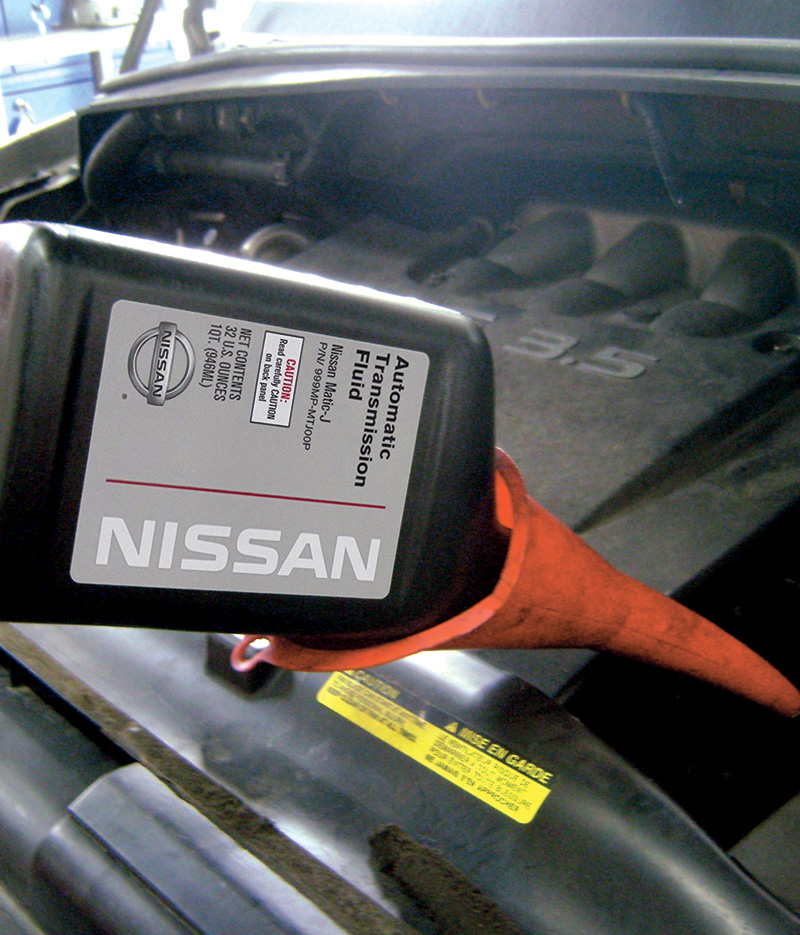
A lot of things can go wrong in any repair. At least when you’re using the right fluid you can have peace of mind that’s one less thing to worry about.
The fluids under the hood are critical to driving around the block let alone driving around 300K miles. In the last issue, we discussed the engine oil, crucial to be sure, but it’s not the only fluid that can bring a car to an untimely end. From cooling systems to differential fluid, from automatic transmissions to brakes, paying attention to the fluids you use can make all the difference in the world.
Let’s take a stroll through the now complex issue of fluid selection. With so many different technologies going into today’s vehicles, the days of universal fluid have gone away. The aftermarket fluid manufacturers have found a market in trying to bring back the “universal†in fluids. It’s easy to be tempted, in our fast-paced shops, to go for the quick fix of the universal fluid. In the end, however, it’s seldom the best result for the long term, and sometimes it can even cost you in the short term.
The engineers that designed the systems you are working on have very specific reasons for choosing the fluids they specify. Cooling systems may seem simple from the outside. You take heat from the engine block and move it to the radiator. Even plain old water can do that. You should keep in mind, however, that it’s not that simple.
In a cooling system you must consider the surfaces the coolant contacts, the size of the passages it flows through, the physical mass of the fluid, how the thermal expansion affects the volume of the fluid, its pH balance, as well as a hundred other aspects. Get the viscosity of the coolant wrong and it can break the impeller off the water pump. Get the pH wrong and corrosion can eat through a heater core. Get the boiling point wrong and the system will boil over. Get the freezing temperature wrong and it can be the end of an engine block. All this and we’re still only talking about the cooling system. How much more complex are the other systems in the vehicle? Â
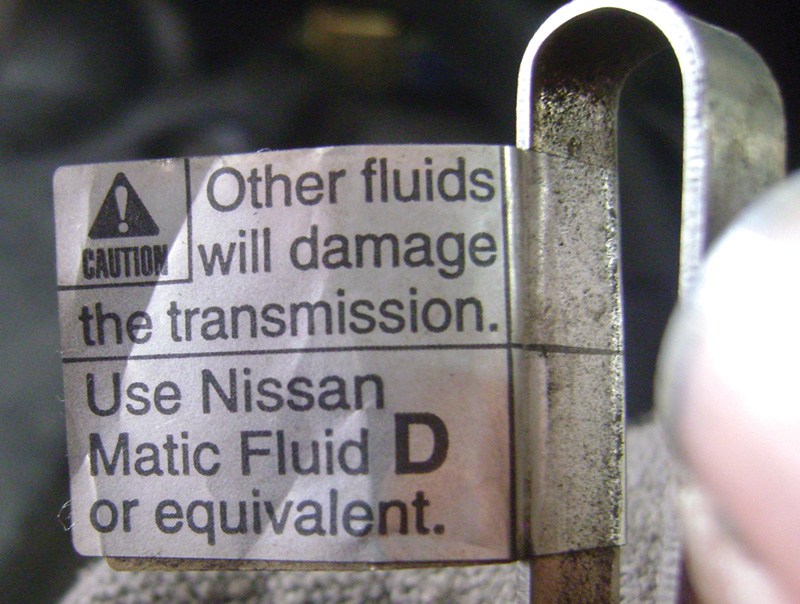
These instructions are pretty clear and the consequences of not following them are spelled out as well. This leaves little excuse for using the wrong ATF.
The obvious system that most requires specific fluid is the automatic transmission. What makes filling these sophisticated gear boxes even tougher is the seemingly endless selection of fluids that will probably work, for a while anyway. The goal here is to get the right fluid in the car. Putting the wrong type of fluid in a transmission can and will cause problems very quickly.
In today’s marketplace, there are many fluids that claim to be universal. Manufacturers often tout a long list of OE fluids that their synthetic transmission fluid will replace. The problem is that transmissions are not all the same. They each have different amounts of torque to transmit, different amounts of slip built into their functions, different friction materials, different filtration, cooling, and many other dynamics that are anything but universal. Transmissions are easy to damage and expensive to replace. Making sure you have the best fluid for your specific application is the right call. Trusting the engineers that designed your transmission in the first place will insure that you get the best fluid.
The first step in making sure you have the right fluid is knowing what the right fluid is. This is not a difficult piece of information to find. Often the fluid type will be written right on the dipstick itself. Even if it isn’t quite that easy it’s still worth spending a couple minutes on the computer to make sure you get the right fluid.

The 5 speed FWD transmission is easy to identify with a unique dipstick handle. Read the sticker; this one doesn’t run on Matic D, make sure you use the Matic K as directed.
Although it may be acceptable to use Type S in place of Type J, you will find yourself in a world of hurt if you use either in an Xtronic CVT. The basic difference is that Type J is a standard base automatic transmission fluid and Type S is fully synthetic. That doesn’t mean that just because some off-brand fluid claims to be fully synthetic and completely universal that it would be a suitable replacement for either. The fluid must have the correct friction modifiers, viscosity, detergents, anti-foaming agents and a dozen other properties to be exactly right for the transmission. That’s not to say that an off brand won’t have those aspects, the question is; how would you know? The simple answer is just use genuine Nissan fluid and you won’t have to guess.
To give you an idea as to which transmissions take which fluids, we can examine TSB NTB08-049b. This applies to all Nissan vehicles 2002 to present. Without regard to specific year or application we can get an idea of what fluid each transmission will use by how advanced it is.
For example; a 4-speed transmission is less advanced than a 5-speed transmission and the fluid requirements reflect this. The 4-speed takes Nissan Matic D whereas the 5-speed will take Matic K, S, or J. The 7-speed ,being more advanced than either the 4 or 5-speed, will take Nissan Matic S only. Although this seems like a simple system it’s only useful if you know how many gears you have. Unfortunately, that isn’t often written on the gear shift and you will probably be looking it up anyway. You might as well just look up the fluid type while you’re there. If you do check out this TSB, take a peek at the footnotes. You will notice that Nissan strongly recommends you use genuine Nissan ATF.
This idea gets a lot more important when we start working on CVT transmissions. These transmissions don’t work like the old technology automatic transmissions that have been around since the 1940’s. Instead of several stacks of clutch plates, these transmissions use a steel belt and variable pulleys. It’s not the same device, it doesn’t take the same juice. Putting old fashioned ATF in them will most certainly lead to big headaches.

This chart is an easy way to see the advancements in transmission fluids as the transmissions advance in technology and complexity. This chart is from TSB NTB08-049 and may not include changes in 2013 and newer CVT transmissions.
Nissan CVT fluid type NS-2 (P/N 999MP-NS200P) and NS-3 (P/N 999MP-NS300P) are the right fluids for most CVTs with one exception. Generally, 2012 and older use NS-2, and 2013 and newer use NS-3.
The exception we need to be aware of is the Altima Hybrid Transaxle (eCVT) that requires Nissan Matic W (P/N 999MP-MTW00P). If you’re not sure, play it safe and look it up. Mistakes in fluid type are easy to avoid with a little effort. There are some aftermarket companies that claim to have a compatible product, but for how long the fluid lasts, going cheap doesn’t make the most sense. The simple fact is this: you are not going to have a good experience if you use anything that has the word universal on the bottle in these transmissions. It’s not a universal machine.
Manual transmissions are a bit more forgiving but not bullet proof. Although the basic viscosity may be the same across all the brands, that is about where the similarities end. Much like motor oil, different brands of gear oil have different formulations. For the longest lasting bearings, synchronizers and gear sets the first step is going to be making sure the transmission has enough gear oil in it. Regardless of which fluid you put in it, running a manual transmission low on fluid will quickly destroy the bearing and gear surfaces. The reason this is important to mention is that it is often overlooked. Since there is no dipstick to check, technicians will often neglect to pull the fill plug and check the actual fluid level and quality. A small leak from an output shaft seal over years can run the fluid level low enough to cause damage. Genuine Nissan MTF (manual transmission fluid) is easy assurance that you have the best fluid in the transmission, but even that won’t help if there isn’t enough in the case to begin with.
As far as which viscosity to use, there is a little variation over the years. Prior to 1998 Nissan vehicles from Pathfinder to Sentra use different viscosities based on the temperatures at which they are expected to run. Unless you are expecting some temperature extremes, go for the middle of the scale. 80W, 90W or 75W-90, 80W-90 are great choices for most situations.
After 1998 all Nissan and Infiniti manual transmissions call for multi-weight MTF with a few notable exceptions; the GT-R will be using its own special fluid. Nissan transmission oil R35 special is the only fluid to use on this vehicle. If you intend on using an alternative you will need to double check with a CAT scan to insure there isn’t anything wrong with your head. The fluid is expensive but it’s absolutely required.
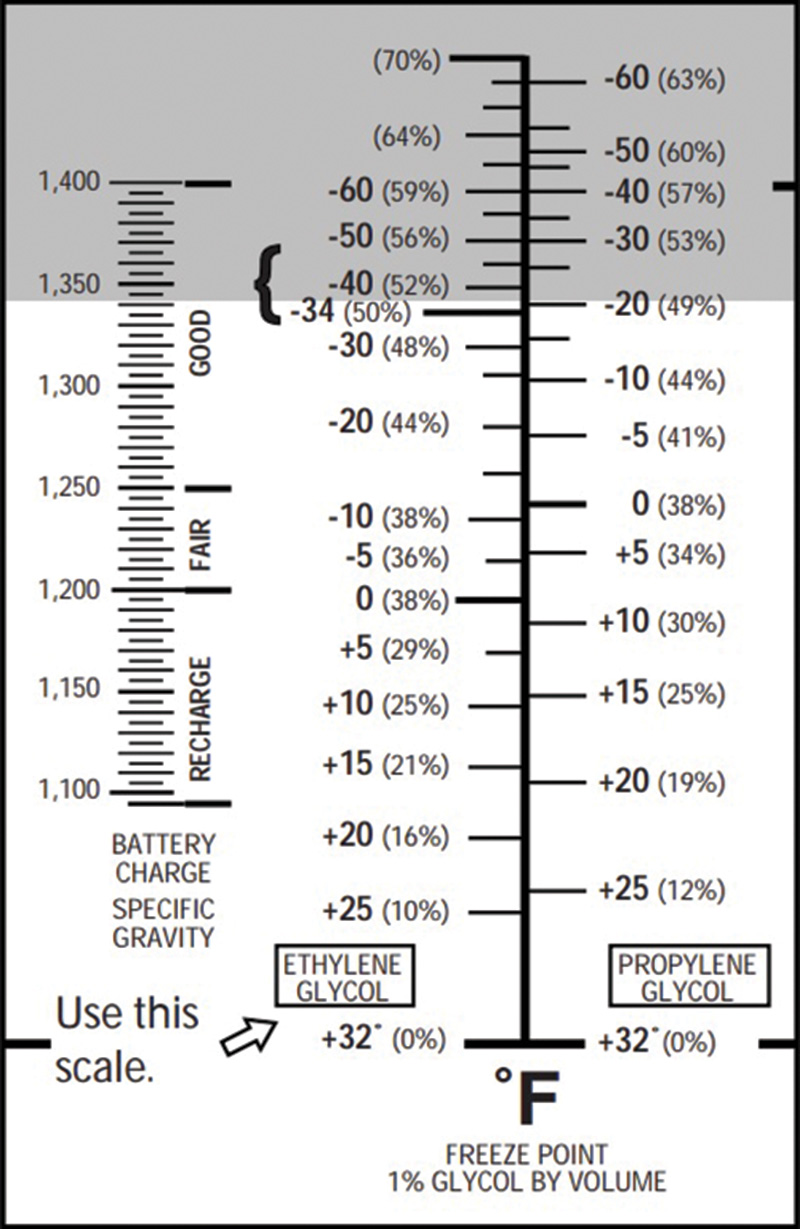
In order to get coolant that doesn’t freeze in winter and yet flows freely enough to heat the passenger compartment, using a refractometer to make sure your coolant is perfect is the right move. TSB NTB02-047c addresses a possible problem with 2002-2006 Altima heater flow. The wrong coolant in the wrong concentration can cause heating problems.
Another exception is the 6-speed manual transmission in such vehicles as the 2007-2010 Versa and Sentra as well as in the 2009-2010 Cube. These transmissions call for Nissan TransElf NFJ 75W-80. You may get away with using a universal fluid, but your customer’s shift quality and transmission durability may suffer for it. You may notice a recurring theme here; you don’t fill these transmissions very frequently, don’t go cheap! Get the right fluid in them. Genuine Nissan MTFs are the best bet. Â
As we alluded to earlier in the article, coolant choice isn’t quite as simple as just pouring in whatever green stuff came out of the 55-gallon drum in the back of the shop. For the best performance and corrosion resistance, in 2009 Nissan started putting new long-life antifreeze coolant (LLC) in some new vehicles. More vehicles were added in 2010 and by 2011, and each year since, all new vehicles were filled with the new blue antifreeze.
For the technician, this change means an increase in the service life of the coolant and a little more flexibility. Even though the new Nissan blue coolant lasts longer, it can be mixed with the older Nissan green coolant. The only down side to such mixing is that the service life should be treated as the older coolant, with a service life of 4 years/60K miles as opposed to the LLC service life of 5 years/75K miles. For vehicles in extreme cold conditions Nissan also offers the blue coolant in a concentrated form to be added directly to the cooling system to increase its freezing resistance (P/N 999MP-L255QTP).
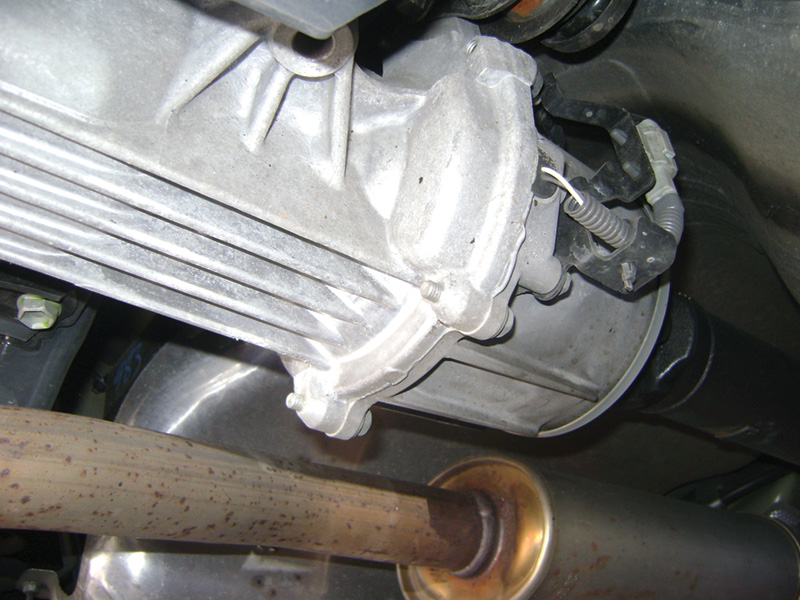
With electronically controlled internal clutches, this rear end isn’t as forgiving as older differentials. A leak caused by using the wrong fluid can cost you. Make sure you get the right, genuine Nissan fluid in it.
Another area that is often overlooked is gear oil selection for differentials. Choosing the right fluid is important for a few reasons. First is protection from the intense pressures developed in the gear set. All the torque of the engine, multiplied by the gearing in the transmission, passes through the ring and pinion gear.
Second is heat dissipation. Differentials with incorrect fluid can and will overheat, burning the gear oil and decreasing its effectiveness, especially while towing.
Third is fuel economy. The more viscous the gear oil, the more energy it takes to move the gears that are swimming in it.
These aspects and more must be taken into consideration when selecting the right gear oil. Be sure to follow the service manual specifications and TSBs over what might appear in the owner’s manual. One example of a change that was made is the 2004 Titan. Originally it was serviced with GL-5 80W-90 gear oil. Nissan has updated that recommendation for towing and other heavier uses and now strongly recommends Nissan 75W-140 synthetic gear oil and that, when used for towing or other heavy-duty use, it be changed every 30K miles or 2 years, whichever comes first. This change will eliminate some of the premature wear seen in these differentials.
Brake fluid is in a different classification than the other fluids we have been reviewing here. Brake fluid is highly regulated by its attributes and is classified by the federal government. If the specification for your vehicle is DOT 3 brake fluid you should use DOT 3 brake fluid. Mixing brake fluids is not OK under any circumstance. The seals in the brake system components are specifically designed to be used with the specific type of fluid they call for.

Test the water content of the brake fluid with an electronic tester or even these inexpensive test strips. Don’t just assume that, if it’s clean it’s good.
Silicone based DOT 5 sounds great in that it doesn’t absorb water, it doesn’t harm painted surfaces and it boils at a much higher temperature. DOT 5 also doesn’t lubricate ABS pumps, and can cause them to fail. Glycol based brake fluids like DOT 3 have their problems (namely water absorption) but they were chosen because they do their job very well and the tightly controlled minimum specifications make them very reliable. This is just what you want in a brake system. The federal government only controls the attributes of the fluid, not the quality. Genuine Nissan brake fluid is the safe bet for brakes and hydraulic clutch systems.
Flushing the brake fluid regularly is an important maintenance item. Recommended intervals range from approximately 1 to 2 years. The main reason for the frequency of the fluid changes is the natural tendency of brake fluid to absorb water. As the fluid absorbs water it boils at a lower temperature, creates a softer brake pedal feel, and can even damage internal brake system components by allowing corrosion. Brake fluid can and should be tested regularly for water content with either test strips or an electronic moisture detector. Keeping the fluid clean and dry will prevent many brake system problems.
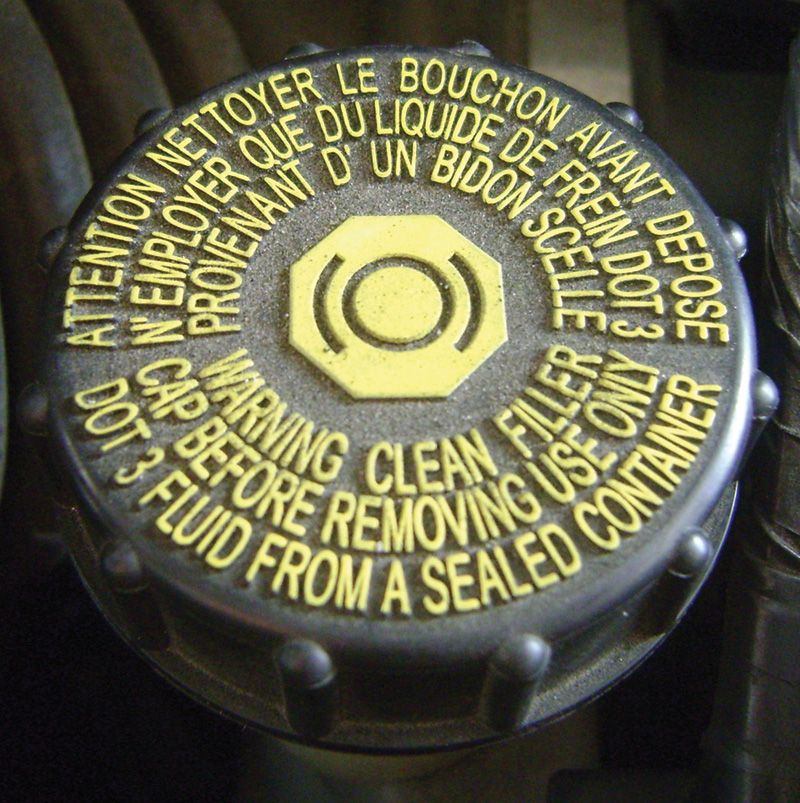
There is little variation in what fluid goes in the master cylinder of any street car and yet it’s still labeled clearly “DOT 3.â€
The fluids you choose to use in your repairs is becoming a more important decision as the technology of the components increases. Gone are the days of one size fits all drums of motor oil and transmission fluid. Using the right fluids will help to insure that your customers’ vehicles perform the best they can for many years to come. Doing so will also increase your customers’ confidence in your repairs, knowing that you’ve done your research and chosen the best product for their vehicle. The extra cost over the cheap alternatives may not be right for every situation but the more you choose genuine parts, the less you have to worry about unforeseen compatibility problems.






0 Comments